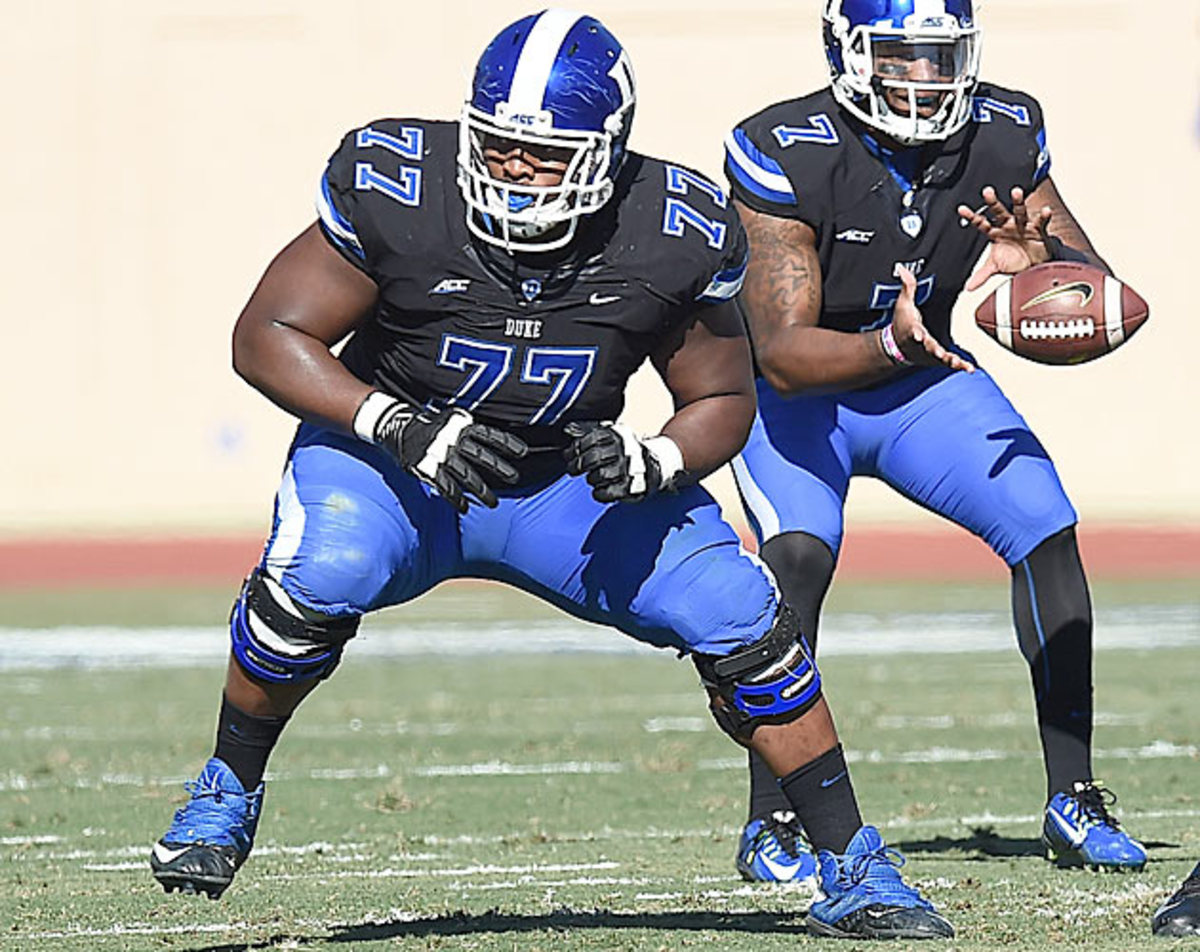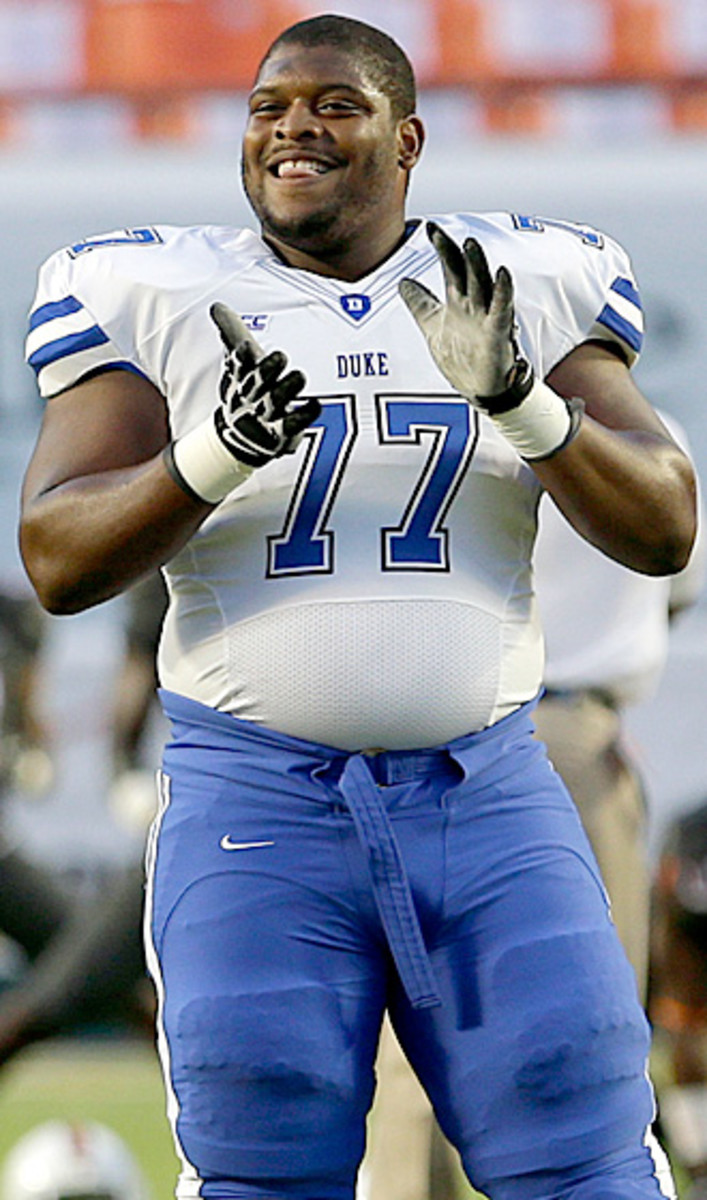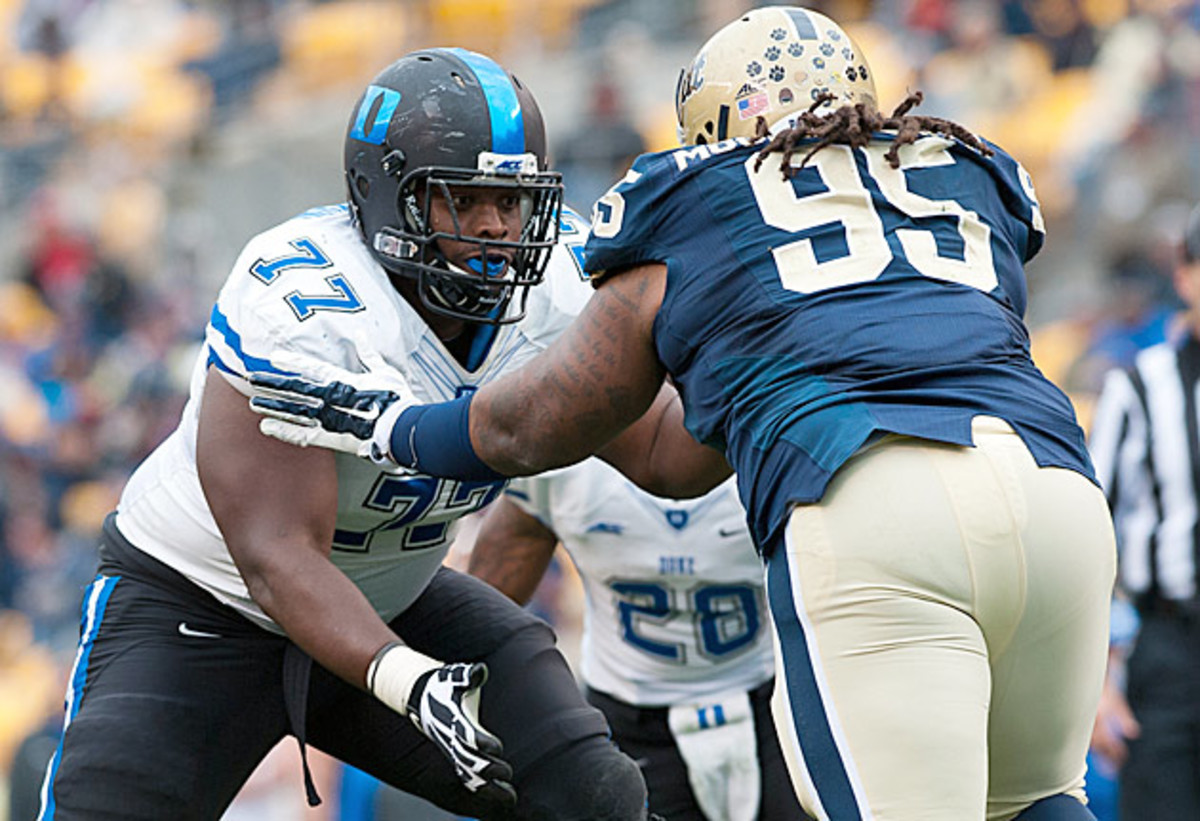Duke's Laken Tomlinson takes long road from Jamaica to All-America

Laken Tomlinson awoke every weekday before 5:30 a.m., well before the sun rose above his mother’s apartment, and stepped out into the often cold and occasionally dangerous streets of the Rogers Park neighborhood in Chicago. He’d walk to the L stop to catch a Red Line train down to Addison, and then he’d catch the 152 bus, riding that to the Addison/Western stop. Nearly an hour after he had left home, he would finally arrive at Lane Tech College Prep.
“There’s a lot of people, adults, who can’t do that for a living,” says David Cutcliffe, Tomlinson’s coach at Duke. “And Laken had no tardies and no absences.”
Tomlinson didn’t have to make such a difficult trip. He could have climbed out of bed later, stayed in Rogers Park and walked a few minutes to Roger C. Sullivan High. Then again, if he had done that he wouldn’t be the person he is, and he probably wouldn’t be a first-team All-America offensive guard for the Blue Devils.
“I’d rather go to a good school far away than a poor school that wasn’t going to get me prepared for life,” Tomlinson says.
It was a series of decisions to make the longer trip that turned the 10-year-old boy from Jamaica who arrived in the United States on a frigid night into a star football prospect on the verge of reaching the NFL. That is, as long as a career in medicine doesn’t take precedence.
• RICKMAN: Athletic Duke, Arizona State to meet in Sun Bowl
*****

Born in Savanna-la-Mar in the Westmoreland Parish of Jamaica, Tomlinson’s early childhood was simple: He would run around barefoot with his friends, climbing trees and playing soccer and cricket.
About a decade before he was born, Tomlinson’s grandparents had emigrated from Jamaica to Chicago to set up life in the U.S. and hopefully bring many of their 10 children over, too, as soon as they could afford it. When Tomlinson was 9, his mom told him the time had come to make the move. After a year of filling out paperwork to get their visas, Tomlinson, his mother, Audrey Wilson, and siblings, Jehmaul, Juhvane and Chelsea, flew into O’Hare International Airport on a wintery night.
“I remember getting off the plane and out of the airport, and I was like, “Wow, it’s really, really cold,’” Tomlinson says. Luckily, his uncle greeted them with sweaters. “I was really thankful for that,” he says.
Adjusting to the weather was only the first major change. Tomlinson left behind an entire way of life. Running barefoot and playing soccer in the streets were out. “My first couple of months, I just stayed at my place and didn’t really go outside,” he says. “Sometimes it seemed like everything was moving 100 miles per hour, and I couldn’t really catch on to things.”
But even amid the cultural acclimation, Tomlinson showed tremendous potential in the classroom. His principal at Jordan Elementary Community School, Dr. Maurice Harvey, got him involved in Youth Guidance, a program that pairs students with volunteer adult mentors. Tomlinson’s mentor became Bob Sperling, a partner at Winston and Strawn LLP, who grew up in Rogers Park and wanted to help a 10-year-old boy, the same age as his son, Jared. If kids from Jordan were not admitted into a test-in public high school, they’d go to Sullivan, where Sperling had gone.
Sperling, who lives in Glencoe, Ill., went to Jordan and met with five 10-year-old boys, including Tomlinson, whom Harvey had strongly recommended to him. An artistic Tomlinson drew with Sperling and impressed him with his natural ease of conversation. Sperling agreed to mentor him.
Yet a problem soon emerged: Tomlinson’s mom didn’t sign off on his participation. “She’s really traditional, really conservative,” Tomlinson says. “She wanted me to be home, didn’t want me to go out and do extra stuff. She’d rather have me home studying rather than meeting with some guy once a week.”
So, Sperling picked a new child to mentor -- until Harvey called the next morning. “He said, ‘I convinced her. Can we go back to playing with Laken?’” Sperling says. “I said, ‘Do whatever you want.’”
Sperling and Tomlinson’s relationship began that weekend, when Sperling invited Tomlinson, his mom and his younger siblings to dinner at his home. From that point on, Tomlinson would regularly spend time outside of school with Sperling and his family. Sperling began each visit by making sure Tomlinson had completed his homework. They talked about the importance of an education, the adjustment to American culture and the keys to avoiding gangs in Tomlinson’s neighborhood.
But mixed in with the mentoring, Tomlinson frequently played with Jared, who he now describes as “like a brother to me.” They went to Chicago Bulls games and to the beach, and played sports with other kids in the neighborhood. Tomlinson even had a Passover Seder with the Sperlings. “He liked the food,” Bob says.
As middle school came to a close, Tomlinson had grades and test scores that could have gotten him accepted to a test-in high school. But his record showed issues with absenteeism, stemming from Tomlinson occasionally staying home to babysit his younger siblings. Sperling went to bat for Tomlinson, calling Rich Rio, the athletic director and football coach at Lane Tech. “You change one person, you change a family. You change a family, you’ll change the neighborhood,” Sperling told Rio. “Give him a chance.”
• STAFF: Laken Tomlinson honored in SI.com's 2014 All-America Teams
*****
In the summer of 2006, before Tomlinson’s freshman year at Lane Tech, he and his mother walked on the practice field during two-a-days. Given Tomlinson’s massive size -- he estimates he was 6-foot-1 and 250 pounds -- Rio assumed they were lost and looking for a college campus. Wilson explained that Tomlinson was interested in playing high school football but lacked experience. Rio sized up Tomlinson and told Wilson, “Trust me, we’ll get him to play.”
Tomlinson was very raw. “He didn’t really even know how to put on equipment,” Rio says. He had played in a prep league in middle school and had occasionally played pickup football with Jared Sperling and his friends but knew little more than the basics. Tomlinson played on the defensive line in his first game. “They were just like, ‘Go out there and hit someone,’” he says. “I was like, All right, I know to move when the ball is snapped, and then I’ve got to get past these blocker guys, and then I’ve got to just hit the guy with the ball and tackle him to the ground. That was pretty much all I knew how to do.”
Although Tomlinson was eager to learn, he struggled with the sport’s physicality. Seeking to motivate him to play with more aggression, Lane Tech’s offensive line coach, Lou Munoz, began to call Tomlinson “Fluffy.” “I didn’t like it obviously,” Tomlinson says. “And I quickly changed that.”
Under Rio and Munoz’s coaching, Tomlinson flourished, playing for the varsity team as a sophomore and drawing major-college attention as a junior. By his senior year, “Fluffy became an all-stater,” Rio says.
As scholarship offers began pouring in, Wilson didn’t understand the recruiting process. “She had no idea of what was going on, didn’t know what a full-ride scholarship was,” Laken says. “My mentor had to sit down with her and explain to her how much it’d mean for her. I guess she got the full meaning when she realized she wouldn’t have to pay any of my college. She was like, ‘Whoa, nothing?’”
However, even if Tomlinson had never received any of his nearly 30 scholarship offers, his college tuition was taken care of financially. Sperling had previously told him he would pay for college. “He kids me now -- because he’s right -- he saved me a lot of money by being good,” Sperling says.
Sperling became Tomlinson’s point person during the recruiting process, fielding calls from coaches. Of all the scholarship offers that came through, one seemed of particular significance. Sperling was the chairman of the committee on athletics at Illinois and had helped hire Ron Zook, then the school’s coach. When Cutcliffe spoke with Sperling, he asked: “Are you going to be able to tell Ron Zook no?” Sperling replied: “Easily. Because I’m going to have Laken tell him.”
Sperling made Tomlinson call all the coaches he was rejecting, though the Illinois call was tough. “[Zook] will contend that not getting Laken is one of the reasons he lost his job, half kidding, half serious,” Sperling says.

Tomlinson’s decision ultimately came down to Duke and Northwestern. He liked Duke’s strong academic background and enjoyed his conversations with Cutcliffe, particularly due to the coach’s Southern accent, the first one he’d heard. Tomlinson became sold on Duke when he took his unofficial visit. Sperling and Rio had advised him throughout the recruiting process to avoid taking coach’s pitches at face value, and to conduct his own research instead. “I pretty much saw everything [Cutcliffe] had talked to me about was true,” Tomlinson says. “I saw the things that he had preached about happening there at Duke.”
Rio thought Duke would give Tomlinson a strong chance for early playing time, and Sperling and Rio believed it would be beneficial for Tomlinson to be farther away from home than Northwestern. That made Duke a perfect fit, but given Tomlinson had offers from powerhouse programs like Ohio State -- the Blue Devils had won just 10 combined games while he was in high school -- the three-star prospect’s pledge was a major coup for Cutcliffe and his staff. “We were thrilled,” Cutcliffe says. “That was one of the first huge victories we’ve had here in recruiting.”
Of course, on top of everything else, it helped that Duke has one of the strongest medical programs in the country. Tomlinson’s interest in medicine arose from tragic circumstances. When he was in eighth grade he and his brother Jehmaul had to call an ambulance for their grandfather, Ivan Wilson, after he collapsed in his home. Doctors determined Wilson suffered from ulcers that caused him to bleed into his stomach. He remained in the hospital for several weeks and then recovered.
A year and a half later, Wilson traveled to Jamaica to visit relatives who remained on the island when his stomach ulcers flared up again. He died before he could return to the U.S. “I just remember thinking, ‘Wow, this can’t be true,’” Tomlinson says. “It really made me a little bit angry.”
Tomlinson dealt with the tragedy by studying. He researched Jamaica’s healthcare system and wrote a senior paper on it in high school. “That’s pretty much the reason why my grandpa died -- they didn’t have the proper resources there to take care of him,” Tomlinson says. “That angered me even more. That’s kind of when I made the decision I want to be a doctor.”
*****

At Duke Tomlinson is pre-med and a psychology and evolutionary anthropology double major. He had already completed his pre-med requirements before this semester began and finished his major requirements this fall by taking abnormal psychology. Completing difficult coursework while training has been a grind, but Cutcliffe says he never worries about Tomlinson. “The only thing I have to watch with Laken is I tell him every now and then, ‘Relax,’” Cutcliffe says.
Just as he did in middle school and high school, Tomlinson takes academics very seriously. As a captain he helped the Blue Devils set their “indoctrinations,” or rules determined by the players governing their behavior, including in the classroom. He took particular leadership while formulating the academic guidelines before the season, noting, “If you’re not above a 3.0 [GPA] here, you’re a liability” and “If you’re not five minutes early to class and you have not had a conversation with your professor in the first week, then you’re not living up to our standards.”
In addition to the required coursework, Tomlinson has taken steps to further his medical education. This summer he shadowed Dr. Carlos Bagley, a neurosurgeon at Duke University Hospital. Tomlinson came before and after training sessions to observe Bagley in the operating room and meeting with patients. Tomlinson even came back to shadow Bagley during Duke’s bye week in-season.
While planning a career outside of the game might seem practical for most college players, given how few actually make the NFL, Tomlinson could just as easily put more attention into preparing for the 2015 draft. A first team All-ACC selection last year and a first-team AP All-America this year, he is projected to go in the third or fourth round next spring. He could become the first Duke player selected in the first three rounds since 1999.
“There aren’t many that know they have that NFL career on the table kind of right in front of them but still have the forethought to be looking at, ‘OK, what’s next for me?’” says Bagley, who played linebacker at Duke from 1992-95.
Now Tomlinson faces the obstacle of taking the next step in both of his promising careers. He isn’t sure when he’ll take the MCAT but would like to within a year or two. He has even talked with former players who attended medical school while playing in the NFL. He says he would need more info before seriously considering that option, although he admits, “it’s possible.”
“I would like to play football for as long as I can, whether that’s five years, 10 years, 15 years,” Tomlinson says. “But I want to set myself up to continue leading my life once my football career is over, so obviously I’m going to keep on maintaining my interest in going to med school until I do go to med school.”
But first Tomlinson has one last game to play in a Duke uniform, as the Blue Devils prepare to face Arizona State in Saturday’s Sun Bowl. It will be the final achievement for a class that bought in to Duke before Cutcliffe had tangible results to show. After going 3-9 in Tomlinson’s first two seasons on campus, the Blue Devils have gone 25-14 over the past three years. They have a chance to post consecutive 10-win seasons for the first time in program history.
• RICKMAN: Arizona State's Jaelen Strong shines in father's honor
“It’s just really amazing to see all that [Cutcliffe] talked about come to fruition,” Tomlinson says. “It’s crazy how it’s happened so fast. When I first got here, I didn’t think it was going to happen that fast.”
Before the game, Tomlinson will receive his standard pregame text from Sperling: “I love you. I’m proud of you. Be a leader. Play harder. Play 100 percent every play. And always put team before yourself. If your team is successful, you’ll be successful.”
Tomlinson knows all about that last part. After making it this far, he stands ready to create his own successes, no matter which career path he chooses.
